福岛核电站事故分析报告
- 格式:ppt
- 大小:6.23 MB
- 文档页数:18
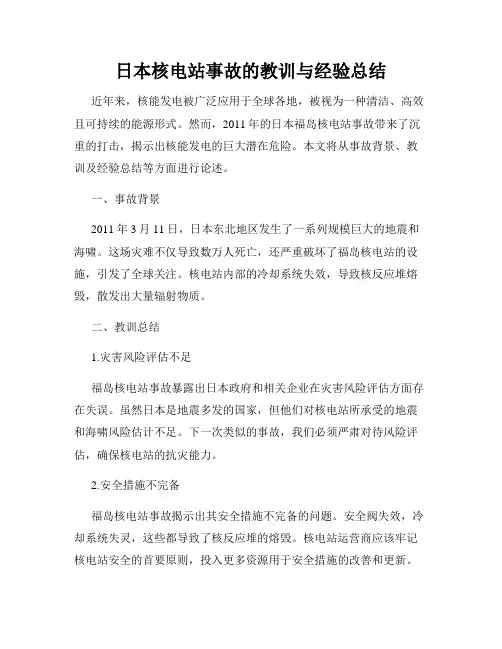
日本核电站事故的教训与经验总结近年来,核能发电被广泛应用于全球各地,被视为一种清洁、高效且可持续的能源形式。
然而,2011年的日本福岛核电站事故带来了沉重的打击,揭示出核能发电的巨大潜在危险。
本文将从事故背景、教训及经验总结等方面进行论述。
一、事故背景2011年3月11日,日本东北地区发生了一系列规模巨大的地震和海啸。
这场灾难不仅导致数万人死亡,还严重破坏了福岛核电站的设施,引发了全球关注。
核电站内部的冷却系统失效,导致核反应堆熔毁,散发出大量辐射物质。
二、教训总结1.灾害风险评估不足福岛核电站事故暴露出日本政府和相关企业在灾害风险评估方面存在失误。
虽然日本是地震多发的国家,但他们对核电站所承受的地震和海啸风险估计不足。
下一次类似的事故,我们必须严肃对待风险评估,确保核电站的抗灾能力。
2.安全措施不完备福岛核电站事故揭示出其安全措施不完备的问题。
安全阀失效,冷却系统失灵,这些都导致了核反应堆的熔毁。
核电站运营商应该牢记核电站安全的首要原则,投入更多资源用于安全措施的改善和更新。
3.应急计划不完善灾难来临时,福岛核电站缺乏有力的应对措施。
这不仅给救援行动带来困难,还加剧了灾害事态的扩大。
应急预案必须在设计时充分考虑各种情况可能出现的影响,提前进行演练和培训,以确保时间紧迫时的迅速响应。
4.信息透明度不足福岛核电站事故发生后,政府和运营商的信息公开不及时、不透明,导致了大量谣言和恐慌的蔓延。
政府和运营商应该及时向公众通报真实的情况,增加信息透明度,以避免公众误解和恐惧的产生。
三、经验总结1.加强核安全监管通过福岛核电站事故,我们认识到核能发电所带来的风险和危害。
为了防范潜在的核事故,必须建立更加严格的核安全监管机制,确保核电站的安全运行。
2.加大科技研发投入核能技术的研发和创新是确保核电站安全运行的关键。
各国应该加大对核能技术的科研投入,寻求更加先进、清洁、安全的核能发电解决方案。
3.注重国际间合作与信息共享核能事故是全球性的问题,各国应加强合作,共享信息和经验。
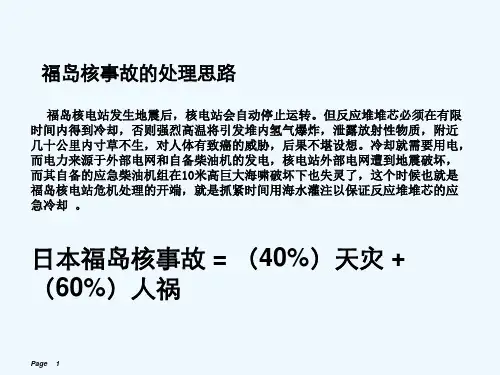
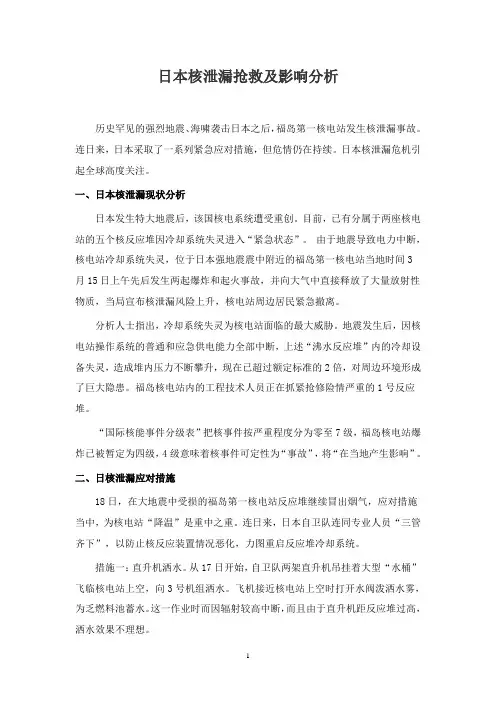
日本核泄漏抢救及影响分析历史罕见的强烈地震、海啸袭击日本之后,福岛第一核电站发生核泄漏事故。
连日来,日本采取了一系列紧急应对措施,但危情仍在持续。
日本核泄漏危机引起全球高度关注。
一、日本核泄漏现状分析日本发生特大地震后,该国核电系统遭受重创。
目前,已有分属于两座核电站的五个核反应堆因冷却系统失灵进入“紧急状态”。
由于地震导致电力中断,核电站冷却系统失灵,位于日本强地震震中附近的福岛第一核电站当地时间3月15日上午先后发生两起爆炸和起火事故,并向大气中直接释放了大量放射性物质,当局宣布核泄漏风险上升,核电站周边居民紧急撤离。
分析人士指出,冷却系统失灵为核电站面临的最大威胁。
地震发生后,因核电站操作系统的普通和应急供电能力全部中断,上述“沸水反应堆”内的冷却设备失灵,造成堆内压力不断攀升,现在已超过额定标准的2倍,对周边环境形成了巨大隐患。
福岛核电站内的工程技术人员正在抓紧抢修险情严重的1号反应堆。
“国际核能事件分级表”把核事件按严重程度分为零至7级,福岛核电站爆炸已被暂定为四级,4级意味着核事件可定性为“事故”,将“在当地产生影响”。
二、日核泄漏应对措施18日,在大地震中受损的福岛第一核电站反应堆继续冒出烟气,应对措施当中,为核电站“降温”是重中之重。
连日来,日本自卫队连同专业人员“三管齐下”,以防止核反应装置情况恶化,力图重启反应堆冷却系统。
措施一:直升机洒水。
从17日开始,自卫队两架直升机吊挂着大型“水桶”飞临核电站上空,向3号机组洒水。
飞机接近核电站上空时打开水阀泼洒水雾,为乏燃料池蓄水。
这一作业时而因辐射较高中断,而且由于直升机距反应堆过高,洒水效果不理想。
措施二:地面注水,与洒水目的一样,都是为核设施蓄水降温。
17日警方高压水车进入福岛第一核电站区域,向3号机组注水。
措施三:抢修电力。
通向核电站的输电线已经铺设,计划18日由东京电力公司提供电力,首先恢复因地震停止的1、2号机组电力系统。
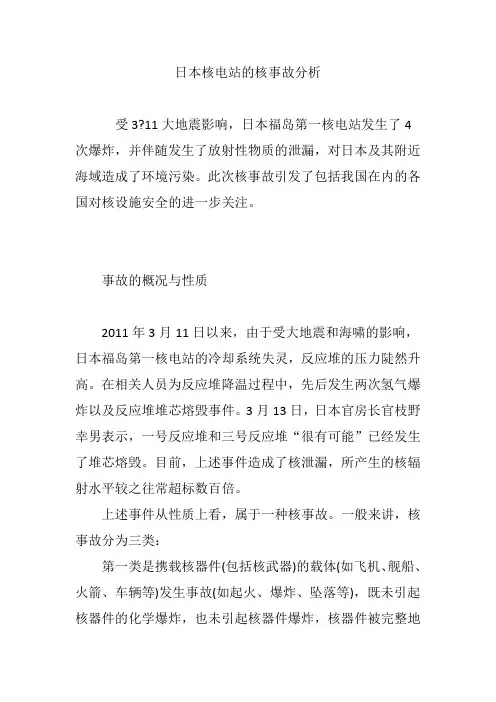
日本核电站的核事故分析受3?11大地震影响,日本福岛第一核电站发生了4次爆炸,并伴随发生了放射性物质的泄漏,对日本及其附近海域造成了环境污染。
此次核事故引发了包括我国在内的各国对核设施安全的进一步关注。
事故的概况与性质2011年3月11日以来,由于受大地震和海啸的影响,日本福岛第一核电站的冷却系统失灵,反应堆的压力陡然升高。
在相关人员为反应堆降温过程中,先后发生两次氢气爆炸以及反应堆堆芯熔毁事件。
3月13日,日本官房长官枝野幸男表示,一号反应堆和三号反应堆“很有可能”已经发生了堆芯熔毁。
目前,上述事件造成了核泄漏,所产生的核辐射水平较之往常超标数百倍。
上述事件从性质上看,属于一种核事故。
一般来讲,核事故分为三类:第一类是携载核器件(包括核武器)的载体(如飞机、舰船、火箭、车辆等)发生事故(如起火、爆炸、坠落等),既未引起核器件的化学爆炸,也未引起核器件爆炸,核器件被完整地回收,环境也未受到放射性污染,也就是说也基本上没有辐射危害。
第二类是核器件或核设施中的化学物质爆炸(包括整装核弹头的化学爆炸),但未引起核爆炸。
可能引起此类事故的原因有:设备缺陷,突发供电事故,运输事故,核弹头或贮管和运输设备安全性下降或失效,火灾等。
此类事故容易引发对人体、动植物以及环境的核辐射,同时还可能造成非辐射危害,如铍、锂、铅等物质的危害,破坏人体健康(如导致白血病,癌症等)。
第三类是核爆炸,有核能释放并引起核器件(含核武器)爆炸的一切后果,包括光辐射、冲击波、早期核辐射、核电磁辐射和放射性沾染等。
尽管截止到目前为止,尚未发生过核武器爆炸事故,但发生过类似于前苏联切尔诺贝利核电站的核反应堆爆炸事故。
此类事故属特大事故,可对人员和环境造成极其严重和长期的伤害。
在此次日本福岛核电站事故中,核辐射通过水蒸汽和积水外排的方式泄漏出来,这并非核反应堆里的裂变层的放射性释放,也不是核爆炸事故而是化学反应事故,因此属于第二类事故。
事故的原因此次日本福岛核电站发生的核事故除了天灾的原因之外,还暴露出日本核电发展、运行、监管中存在的深层次问题。
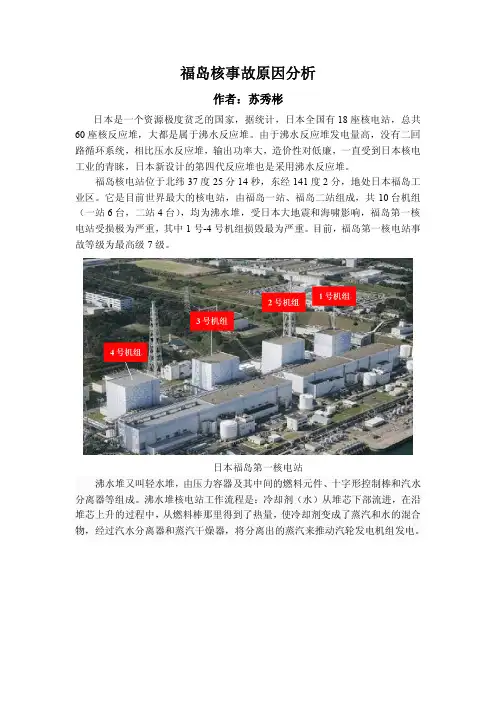
福岛核事故原因分析作者:苏秀彬日本是一个资源极度贫乏的国家,据统计,日本全国有18座核电站,总共60座核反应堆,大都是属于沸水反应堆。
由于沸水反应堆发电量高,没有二回路循环系统,相比压水反应堆,输出功率大,造价性对低廉,一直受到日本核电工业的青睐,日本新设计的第四代反应堆也是采用沸水反应堆。
福岛核电站位于北纬37度25分14秒,东经141度2分,地处日本福岛工业区。
它是目前世界最大的核电站,由福岛一站、福岛二站组成,共10台机组(一站6台,二站4台),均为沸水堆,受日本大地震和海啸影响,福岛第一核电站受损极为严重,其中1号-4号机组损毁最为严重。
目前,福岛第一核电站事故等级为最高级7级。
日本福岛第一核电站沸水堆又叫轻水堆,由压力容器及其中间的燃料元件、十字形控制棒和汽水分离器等组成。
沸水堆核电站工作流程是:冷却剂(水)从堆芯下部流进,在沿堆芯上升的过程中,从燃料棒那里得到了热量,使冷却剂变成了蒸汽和水的混合物,经过汽水分离器和蒸汽干燥器,将分离出的蒸汽来推动汽轮发电机组发电。
福岛第一核电站结构设计图通常,为了安全起见,反应堆冷却系统有三种供电方式。
分别为电网供电,柴油机供电和汽轮机发电供给。
大地震摧毁了核电站的外部电力供应,循环冷却系统在没有电力供应的情况下停止运转,此时核电站紧急启动了柴油发电机组,来维持循环冷却系统的运行,但不幸的是海啸来了,海水灌入摧毁了发电机组。
发电机组损坏之后,核电站启动了备用电池,这种备用电池大概能维持循环冷却系统8小时运行所需要的电力。
在这8个小时内,需要找到另外一种供电措施。
通过卡车运来了移动式柴油发电机,更不幸的事情发生了,运过来的柴油发电机竟然因为接口不兼容无法连接,8小时过后循环冷却系统停止运转。
我们知道:福岛第一核电站一号但是停堆之后,反应堆中的放射性物质仍然有少量在继续衰变,放出衰变能。
这个能量大约占反应堆总输出功率的1%左右。
那么这样计算来看,停堆之后反应堆仍然有4.6万千瓦的输出,但是输出功率只占反应堆总功率的33%左右,也就是说实质上,停堆之后的福岛一号反应堆中总放射性衰变能在13.8.万千瓦左右。
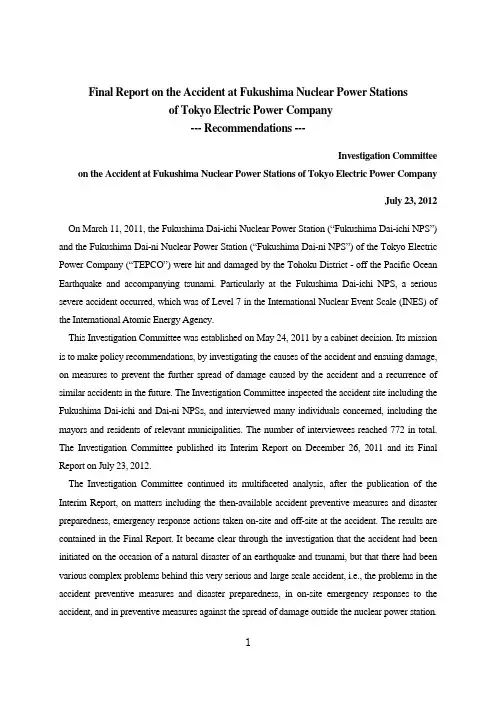
Final Report on the Accident at Fukushima Nuclear Power Stationsof Tokyo Electric Power Company--- Recommendations ---Investigation Committee on the Accident at Fukushima Nuclear Power Stations of Tokyo Electric Power CompanyJuly 23, 2012On March 11, 2011, the Fukushima Dai-ichi Nuclear Power Station (“Fukushima Dai-ichi NPS”) and the Fukushima Dai-ni Nuclear Power Station (“Fukushima Dai-ni NPS”) of the Tokyo Electric Power Company (“TEPCO”) were hit and damaged by the Tohoku District - off the Pacific Ocean Earthquake and accompanying tsunami. Particularly at the Fukushima Dai-ichi NPS, a serious severe accident occurred, which was of Level 7 in the International Nuclear Event Scale (INES) of the International Atomic Energy Agency.This Investigation Committee was established on May 24, 2011 by a cabinet decision. Its mission is to make policy recommendations, by investigating the causes of the accident and ensuing damage, on measures to prevent the further spread of damage caused by the accident and a recurrence of similar accidents in the future. The Investigation Committee inspected the accident site including the Fukushima Dai-ichi and Dai-ni NPSs, and interviewed many individuals concerned, including the mayors and residents of relevant municipalities. The number of interviewees reached 772 in total. The Investigation Committee published its Interim Report on December 26, 2011 and its Final Report on July 23, 2012.The Investigation Committee continued its multifaceted analysis, after the publication of the Interim Report, on matters including the then-available accident preventive measures and disaster preparedness, emergency response actions taken on-site and off-site at the accident. The results are contained in the Final Report. It became clear through the investigation that the accident had been initiated on the occasion of a natural disaster of an earthquake and tsunami, but that there had been various complex problems behind this very serious and large scale accident, i.e., the problems in the accident preventive measures and disaster preparedness, in on-site emergency responses to the accident, and in preventive measures against the spread of damage outside the nuclear power station.Examples are: the then-available accident preventive measures and disaster preparedness of TEPCO and the Nuclear Industry and Safety Agency (“NISA”) were insufficient against tsunami and severe accidents; the preparedness for a large-scale complex disaster was insufficient; and they were unprepared for the release of a large amount of radioactive materials into the environment caused by a containment failure. Inadequate TEPCO emergency responses to the accident at the site were also identified. Furthermore, in the preventive measures against the spread of damage taken by the central and local governments, problems were identified which lacked consideration to the victims, such as the radiation monitoring operation, the utilization of the System for Prediction of Environmental Emergency Dose Information (SPEEDI), evacuation instructions to the residents, responses to the people’s radiation exposure, or the provision of information to the nation and outside the country. In addition, problems of the crisis management system of the government came to light, too.The investigation thus far has suggested that radical strengthening revision be required of the measures for preventing a recurrence of a grave accident at the nuclear power station, and for limiting/mitigating the spread of damage. In this context, the Investigation Committee has made a number of recommendations in the Final Report (It also reproduces the recommendations made in the Interim Report).This document excerpts the recommendations which the Investigation Committee made in the Final Report. The Investigation Committee believes that the realization of these recommendations be useful and important for preventing a recurrence of a nuclear disaster and mitigating its damage. The central and local governments concerned, nuclear operators and other relevant organizations are strongly urged to incorporate and act upon these recommendations in their safety measures and disaster preparedness.The English version of the Interim Report of the Investigation Committee and its Executive Summary is available on the Committee’s website (http://icanps.go.jp/eng/). The English version of the Final Report and its Executive Summary will also be uploaded shortly.(1)Recommendations for a basic stance for safety measures and disaster preparednessRecommendations for disaster preparedness in light of complex disasters in mind (Final Report VI. 2. (2))When reviewing the existing safety measures at nuclear power stations, risks of a large scale complex disaster should be sufficiently considered in disaster preparedness.●Recommendations for changing an attitude to see risks (Final Report VI. 2. (3))i.It is necessary to humbly face the reality of natural threats, diastrophism and othernatural disasters, which are sizable in scale and time, keeping in mind that Japan has often had them in its long history.ii.Risk reduction should be tackled in a drastically different approach. In the government as well as in private entities, a new approach to safety measures and disaster preparedness should be established for a disaster which potentially brings about serious damage in broad areas like a gigantic tsunami or the severe accident at the Fukushima Nuclear Power Station, regardless of its probability of occurrence.iii.An institutional framework is needed to ensure continued in-depth examination of “residual risks” or “remaining issues” without leaving them behind beyond the predetermined safety measures and disaster preparedness.●Recommendations for “deficiency analyses from the disaster victims’ standpoint” (FinalReport VI. 2. (4))An accident at a nuclear power station has risks to bring about damage in vast areas.Nuclear operators on one hand, nuclear regulators on the other, should establish a systematic activity to identify all risk potentials from the “disaster victims’ standpoint,” when designing, constructing and operating such nuclear systems, for ensuring credible nuclear safety including evacuation planning in the local society. Such an approach should be practiced.Radioactive materials may scatter over vast areas due to an accident at a nuclear power station. The prefecture and local municipalities involved should closely collaborate in building up an effective system through evacuation planning and its drills for minimizing confusion.●Recommendations for incorporating the latest knowledge in the disaster prevention plan(Final Report VI. 2. (5))i.Scientific knowledge of earthquakes is not sufficient yet. The latest research resultsshould be continually incorporated in disaster preparedness. In other words, a policy/rule concluded at a certain point based on the then-available knowledge shouldbe reviewed with flexibility and revised, without groundless procrastination, when newknowledge of earthquakes and tsunami become available.ii.If an area is excluded, due to limited financial resources or other reasons, from the areas for strengthening disaster preparedness because of low or unknown probabilitiesof occurrence, the damage would be extremely serious once a massive earthquake andtsunami hit the area. Administrative bodies should take initiatives of, for instance,launching research projects on earthquake evaluation in specific areas for which someseismologists warn of risks, even if few in number, or which show traces of massiveearthquakes and gigantic tsunami (tsunami deposits, for instance) from the remotepast; or formulating an innovative disaster prevention plan in full cooperation of publicadministration, residents and experts through disclosing relevant information.iii.Disaster risks in nuclear power plant siting regions should be noted. It was the role of NISA to prepare for nuclear disasters at nuclear power stations. However, the policy ofthe Central Disaster Management Council has strong relevance to the disasterpreparedness at nuclear power stations. The Central Disaster Management Councilshould duly consider the nuclear power stations, too, in its policy making.(2)Recommendations for safety measures regarding nuclear power generation●Recommendations for building disaster prevention measures (Final Report VI 2 (1))Quite a number of issues exist, which need highly specialized nuclear knowledge over a wide range for solving technical and nuclear engineering problems concerning the emergency responses to the accident at TEPCO Fukushima Dai-ichi NPS, and the then-available disaster preparedness by the government, TEPCO and other organizations.These issues should be reviewed and resolved, results being shaped into concrete actions, through competent knowledge by stakeholders in nuclear power generation. In doing so, they should sincerely take into consideration the recommendations the Investigation Committee has made and they should do so with accountability to society for its process and results.●Recommendations for the necessity of comprehensive risk analysis (Final Report VI. 2. (4)a. (b))Nuclear facilities are installed in a natural environment, which is really diversified.Nuclear operators should conduct comprehensive risk analysis encompassing the characteristics of the natural environment including the external events, not only earthquakes and their accompanying events but also other events such as flooding, volcanic activities or fires, even if their probabilities of occurrence are not high, as well as the internal events having been considered in the existing analysis. Nuclear regulators should check the operators’ analysis. Nuclear operators should actively utilize currently available methods in their analyses of such external events, even if the Probabilistic Safety Assessment (PSA) approach is not firmly established for them. The government should consider support to promote relevant research programs for such initiatives.●Recommendations for severe accident management (Final Report VI. 1. (4) a. (c))In order to ensure maintaining nuclear safety at nuclear power stations, vulnerability of individual facilities for a wide range of characteristics of various internal and external events should be identified by comprehensive safety analysis, and appropriate measures (severe accident management) against such vulnerability should be examined and placed in shape, assuming a situation in which the core may have serious damage by an accident far exceeding the design basis. The effectiveness of such severe accident management should be evaluated through the PSA or other means.(3)Recommendations for nuclear disaster response systems●Recommendations for reforming the crisis management system for a nuclear disaster (FinalReport VI. 2. (6))Learning from the experience as a result of the accident at the Fukushima Dai-ichi NPS, the crisis management system for a nuclear disaster should be urgently reformed, in which the nuclear emergency response manual should be revised assuming an occurrence of a complex disaster combining an earthquake/tsunami disaster and a nuclear accident. In its reforming process, the strengthening of response capabilities of off-site centers, which are supposed to serve as the base for response during a nuclear emergency (hereafter simply referred to as “off-site centers”), is needed. In addition, it is also required to build a crisis management system by examining how to respond to a situation which a Local NuclearEmergency Response Headquarters cannot handle by convening personnel from relevant emergency responsebodies.●Recommendations for the nuclear emergency response headquarters (Final Report VI. 2. b.(a))The emergency response headquarters should, in general, be located close to the accident site where the relevant information is easy to obtain in a nuclear emergency, and the activities at the accident site are easy to grasp. To promptly collect accurate information is, needless to say, the fundamental principle in a nuclear emergency. The government emergency response headquarters should be set up in a way which enables the government people access to the necessary information while staying in government facilities like the Prime Minister’s Office, without moving to the nuclear operator’s head office.●Recommendations for off-site centers (Interim Report VII. 3. (1) a.)The Government should take prompt actions to ensure that off-site centers are able to maintain their functions even during a major disaster, learning from the fact that the Off-site Center (in Fukushima) became unusable because the risks of radioactive contamination had not been adequately considered beforehand.●Recommendations for the roles of the prefectural government in nuclear emergencyresponses (Final Report VI. 1. (2) c.)In a nuclear disaster, the prefectural government should take a responsible role in front, because the damage can extend to a regional size. The nuclear disaster prevention plan should take this point into account.(4)Recommendations for damage prevention and mitigation●Recommendations for the provision of information and risk communication (Final ReportVI. 2. (7))It is necessary to build mutual trust between the public and the government and to provide relevant information in an emergency while avoiding societal confusion and mistrust. To this end, a risk communication approach on risks and opinion exchanges thereupon should be adopted for a consensus building among all stakeholders based on mutual trust. The government should examine, by institutionalizing an appropriate body,how to provide relevant information in an emergency to the public, promptly, accurately, and in an easily understandable as well as clear-cut (not misleading) manner. Inappropriate provision of information can lead to unnecessary fear among the nation. Therefore, an expert on crisis communication may be assigned for providing appropriate suggestions to the cabinet secretary responsible for information provision to the public in an emergency.●Recommendations for improving radiation monitoring operations (Interim Report VII. 5.(2) d.)i.To ensure that the monitoring system does not fail at critical moments, and to ensurethe collection of data and other functions, the system should be designed against various possible events, including not only an earthquake but also a tsunami, storm surge, flood, sediment disasters, volcanic eruptions and gale force winds. Measures should be taken to prevent the system from functional failures even in a complex disaster simultaneously involving two or more such events. Furthermore, measures should be developed to facilitate the relocation of monitoring vehicles and their patrols even in a situation where an earthquake has damaged roads.ii.Training sessions and other learning opportunities should be enhanced to raise awareness of the functions and importance of the monitoring system among competent authorities and personnel.●Recommendations for the SPEEDI system (Interim Report VII. 5. (3) c.)In order to protect the lives and dignity of residents caught up in a disaster, and to prevent the spread of harm from the disaster, measures should be developed to improve operational guidelines of the SPEEDI system so that crucial information on radiation dose rates is provided promptly in a manner acceptable to the people. Measures, including hardware and infrastructure-related measures should be developed and implemented to ensure that SPEEDI functions remain operable even during a complex disaster.●Recommendations for evacuation procedures of residents (Items i. to iv. in Interim ReportVII. 5. (4) c. and item v. in Final Report VI. 1. (4) b.)i.Activities to raise public awareness in daily lives are needed to provide residents withbasic, practical knowledge of how radioactive substances are released during a major nuclear accident, how they are dispersed by wind and other agents, and how they fallback to the ground, as well as knowledge of howthe exposure to radiation can affect human health.ii.Local government bodies need to prepare evacuation readiness plans that take into account the exceptionally grave nature of a nuclear accident, periodically conduct evacuation drills in a realistic circumstance, and take steps to promote the earnest participation of residents in those drills.iii.It is necessary to complete, during normal times, readiness preparations, such as drafting detailed plans for ensuring means of transportation, traffic control, securing evacuation sites in outlying areas, and securing water and food supplies at the evacuation site, taking into consideration the situation that the evacuees may number in the thousands to over a hundred thousand . It is especially important to develop measures that support the evacuation of the disadvantaged, such as seriously ill or disabled people in medical institutions, homes for the aged, social welfare facilities, or in their own homes.iv.The above types of measures should not be left up to the local municipal governments, but need in addition to involve the active participation of the prefectural and national governments in designing and operating an evacuation plan and a disaster prevention plan, in consideration of the situation that a nuclear emergency would affect a large area.v.The existing Emergency Planning Zone (EPZ) had been set before the accident on the basic assumption of 8 to 10 km from a nuclear power station, so that the situation could be well dealt with even in an incident far exceeding a hypothetical accident. However, the accident has shown the need to reconsider what accidents to assume and how to designate evacuation areas. Furthermore, the roles of the government in a nuclear emergency are so large that the government responses should not be limited to those areas outside nuclear site boundaries such as the residents’ evacuation. It should also be considered what the government should do to cooperate or support the nuclear operator in a nuclear emergency, in consultation with the operator.Recommendations for administering stable iodine tablets (Final Report VI. 1. (3) e. (c)) In the existing emergency preparedness, administration of stable iodine tablets is, inprinciple, subject to the judgment of the government NERHQ. A system which allows local municipalities to independently administer the tablets should be reconsidered, and so is the appropriateness to distribute them in advance to the residents as a precaution.●Recommendations for radiation emergency medical care institutions (Final Report VI. 1. (3)e. (f))A considerable number of medical facilities for initial radiation emergency medicaltreatment should be located in the area which is not likely to be included in an evacuation designated area, so that radiation emergency medical care could be provided even in a severe accident like the accident at Fukushima Dai-ichi NPS. Those medical facilities should not be concentrated in the area close to the nuclear power station. At the same time, such medical care systems in a nuclear emergency would need to be coordinated for collaborating over a wide area across the prefectural borders.●Recommendations for public understanding of radiation effects (Final Report VI. 1. (3) e.(g))As many opportunities as possible should be institutionalized for the public to get knowledge and deepen their understanding of radiation. By doing so, the individuals should be able to judge the radiation risks based on correct information; in other words, they would be freed from unnecessary fears about, or from underestimating, the radiation risks because of the lack of information.●Recommendations for information sharing with, and receiving support from, overseas(Final Report VI. 1. (3) g. (a), (b))Provision of information to overseas countries is equally important as to the Japanese public, especially to neighboring countries or those countries which have many of their nationals residing in Japan. Active and polite responses should be in place for prompt and accurate provision of relevant information with due consideration to language barriers.International support in a nuclear emergency should be accepted and received as early as possible, when offered, for international comity and for urgently meeting national needs. To avoid confusion and inappropriateness experienced in the early stages at the time of the accident in Fukushima, operation manuals of competent ministries, nuclear operator emergency management operation plans and other relevant materials should prescribe howto respond to such international support.(5)Recommendations for harmonization with international practices●Recommendations for harmonization with international practices such as the IAEA safetystandards (Final Report VI. 1. (7))It is necessary to keep the national regulation qualities constantly updated in line with the nuclear knowledge accumulation and technological development in the international and national community. To this end, continuous efforts are needed to keep the national regulatory guides newest and best while monitoring international standards, such as those at the IAEA. Lessons on nuclear safety should be extracted from the accident, and those lessons and relevant knowledge should be provided to the international community so that they could contribute to the prevention of similar accidents, not only in our country but also in other countries. In the process of revising national regulatory guides, international contribution should be pursued by making efforts to propose them to incorporate into the IAEA standards etc., if they turn out to be effective and useful as international standards.(6)Recommendations for relevant organizations●Recommendations for the nuclear safety regulating body.i.The need for independence and transparency(Interim Report VII. 8. (2) a.)An organization with regulatory oversight over nuclear safety must be able to makedecisions effectively and independently, and must be able to function separately from anyorganization that could unduly influence its decision-making process. The new nuclearsafety regulatory organization should therefore be granted independence and shouldmaintain transparency.The new nuclear safety regulatory organization must be granted the authority, financialresources and personnel it needs to function autonomously as an entity concerned withnuclear safety and should also be given the responsibility of explaining nuclear safetyissues to the Japanese people.anizational preparedness for swift and effective emergency response (Interim Report VII. 8. (2) b.)In light of the serious impact of a nuclear disaster on the nation, the nuclear safety regulatory organization, which would play a key role in disaster response, should, during normal times, work out a disaster prevention plan and implement emergency response drills to facilitate rapid response if a disaster occurs. Furthermore it should foster the specialized skills to provide individuals and organizations responsible for emergency response with expert advice and guidance, and should foster as well the management potential to utilize organizational resources effectively and efficiently.In addition, the nuclear safety regulatory organization must be well aware that its role is to respond responsibly to crises. It should beforehand prepare systems that can deal with a major disaster if it occurs, and develop partnerships with relevant government ministries and agencies and with relevant local governing bodies to create mechanisms for cross-organizational response, with the role of the nuclear safety regulatory organization clearly demarcated.iii.Recognition of its role as a provider of disaster-related information to Japan and the world (Interim Report VII. 8. (2) c.)The new nuclear safety regulatory organization must be fully conscious that the way it provides information is a matter of great importance, and must also, during normal times, establish an organizational framework that enables it to provide information in a timely and appropriate manner during an emergency.iv.Development of competent human resources and specialized expertise (Interim Report VII. 8. (2) d.)The new nuclear safety regulatory organization should consider establishing a personnel management and planning regime that encourages personnel to develop lifetime careers. For example, it should offer improved working conditions to attract competent human resources with excellent specialized expertise, expand opportunities for personnel to undergo long-term and practical training, and promote personnel interaction with other administrative bodies and with research institutions, including those involved in nuclear energy and radiation.v.Efforts to collect information and acquire scientific knowledge (Interim Report VII. 8.(2) e.)The new nuclear safety regulatory organization to be established should keep abreast of trends embraced by academic bodies and journals in the field (including those in foreign countries) and by regulatory bodies in other countries, in order to continue acquiring knowledge that will contribute to its regulatory activities. It must also understand the implications of that knowledge, systematically share and sufficiently utilize such knowledge, and resulting outcomes should be archived and continually utilized as an organization.vi.Active relationship with international organizations and regulatory bodies of other countries (Final Report VI. 1. (5))The fixed number of personnel at a government administrative organization is a collective issue of the all administrative organizations, and not limited to an issue of NISA, etc. But that of the new regulatory body should be duly considered, because of the importance of nuclear safety. The new regulatory body should secure its personnel, should establish an organizational system competent for international contribution, and develop human resources who can take a role in personnel interaction with international organizations or regulatory bodies of other countries.vii.Strengthening of the regulatory body (Final Report VI. 1. (5))In order to ensure nuclear power safety, responses to individual problems encountered are not sufficient. Continuous efforts are needed to keep national regulatory guides updated at their newest and best qualities, with consideration to international trends of safety regulations and nuclear security, not only to the latest scientific knowledge in the country and overseas. Considering that the impact of a nuclear disaster on society can be sizable, emergency preparedness should be fully established during normal times by formulating a disaster prevention plan or by conducting nuclear emergency response drills so that effective and prompt responses could be taken in an emergency. The regulatory organization should foster the specialized skills to provide individuals and organizations responsible for emergency response with expert advice and guidance and should also foster the management potential to utilize organizational resources effectively and efficiently. Appropriate size of budget and human resources should be duly examined.●Recommendations for TEPCO (Final Report VI. 6. e.)TEPCO bears critical responsibilities to society as a nuclear operator primarily responsible for nuclear power plant safety. Nevertheless, TEPCO was not sufficiently prepared for such an accident, that natural disasters including tsunami may lead to large-scale core damage. Furthermore, TEPCO had not taken adequate preparedness for tsunami risks beyond design basis at the Fukushima Dai-ichi NPS. The accident showed quite a number of problems with TEPCO such as insufficient capability in organizational crisis management; hierarchical organization structure being problematic in emergency responses; insufficient education and training assuming severe accident situations; and apparently no great enthusiasm for identifying accident causes. TEPCO should receive with sincerity the problems which the Investigation Committee raised and should make further efforts for solving these problems and building higher level safety culture on a corporate-wide basis.●Recommendations for rebuilding safety culture (Final Report VI. 2. (8))Well established safety culture is vitally important to people’s lives in the nuclear power industry, which may cause serious situations once an accident occurs. In view of the reality that safety culture was not necessarily established in our country, the Investigation Committee would strongly require rebuilding safety culture of practically every stakeholder in nuclear power generation such as nuclear operators, regulators, relevant institutions, and government advisory bodies.(7)Recommendations for continued investigation of accident causes and damage●Recommendations for continued investigation of accident cause (Final Report VI. 2. (9) a.)The government, nuclear operators, nuclear plant manufacturers, research institutions, academies, all such stakeholders (relevant organizations) involved in nuclear power generation should take active roles in investigating the accident and in fact analyses, and continue, in their respective capacities, their comprehensive and thorough investigations of the remaining unresolved problems. The government, in particular, should not conclude its investigations of the Fukushima nuclear accident at the time when this Investigation Committee or the Fukushima Nuclear Accident Independent Investigation Commission。
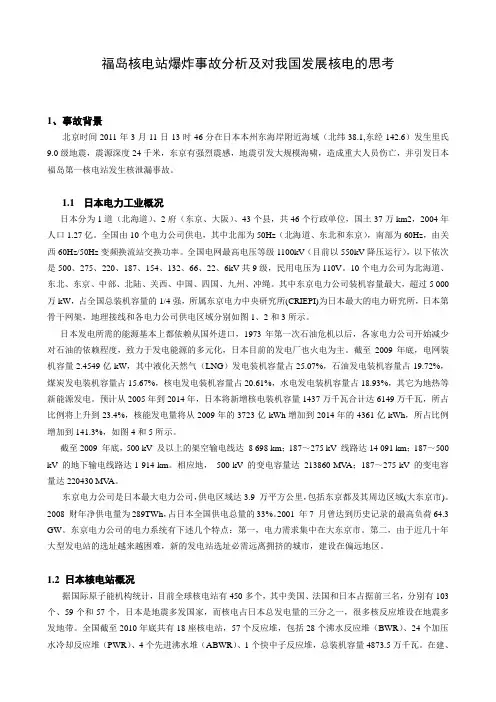
福岛核电站爆炸事故分析及对我国发展核电的思考1、事故背景北京时间2011年3月11日13时46分在日本本州东海岸附近海域(北纬38.1,东经142.6)发生里氏9.0级地震,震源深度24千米,东京有强烈震感,地震引发大规模海啸,造成重大人员伤亡,并引发日本福岛第一核电站发生核泄漏事故。
1.1日本电力工业概况日本分为1道(北海道)、2府(东京、大阪)、43个县,共46个行政单位,国土37万km2,2004年人口1.27亿。
全国由10个电力公司供电,其中北部为50Hz(北海道、东北和东京),南部为60Hz,由关西60Hz/50Hz变频换流站交换功率。
全国电网最高电压等级1100kV(目前以550kV降压运行),以下依次是500、275、220、187、154、132、66、22、6kV共9级,民用电压为110V。
10个电力公司为北海道、东北、东京、中部、北陆、关西、中国、四国、九州、冲绳。
其中东京电力公司装机容量最大,超过5 000万kW,占全国总装机容量的1/4强,所属东京电力中央研究所(CRIEPI)为日本最大的电力研究所,日本第骨干网架,地理接线和各电力公司供电区域分别如图1、2和3所示。
日本发电所需的能源基本上都依赖从国外进口,1973年第一次石油危机以后,各家电力公司开始减少对石油的依赖程度,致力于发电能源的多元化,日本目前的发电厂也火电为主。
截至2009年底,电网装机容量2.4549亿kW,其中液化天然气(LNG)发电装机容量占25.07%,石油发电装机容量占19.72%,煤炭发电装机容量占15.67%,核电发电装机容量占20.61%,水电发电装机容量占18.93%,其它为地热等新能源发电。
预计从2005年到2014年,日本将新增核电装机容量1437万千瓦合计达6149万千瓦,所占比例将上升到23.4%,核能发电量将从2009年的3723亿kWh增加到2014年的4361亿kWh,所占比例增加到141.3%,如图4和5所示。
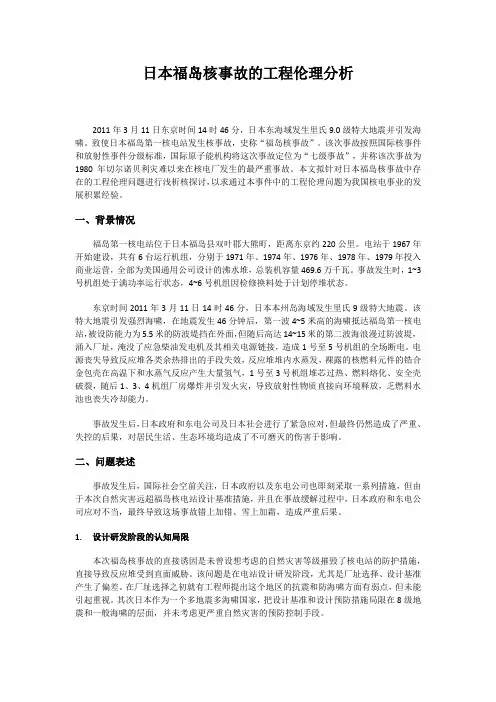
日本福岛核事故的工程伦理分析2011年3月11日东京时间14时46分,日本东海域发生里氏9.0级特大地震并引发海啸。
致使日本福岛第一核电站发生核事故,史称“福岛核事故”。
该次事故按照国际核事件和放射性事件分级标准,国际原子能机构将这次事故定位为“七级事故”,并称该次事故为1980年切尔诺贝利灾难以来在核电厂发生的最严重事故。
本文拟针对日本福岛核事故中存在的工程伦理问题进行浅析核探讨,以求通过本事件中的工程伦理问题为我国核电事业的发展积累经验。
一、背景情况福岛第一核电站位于日本福岛县双叶郡大熊町,距离东京约220公里。
电站于1967年开始建设,共有6台运行机组,分别于1971年、1974年、1976年、1978年、1979年投入商业运营,全部为美国通用公司设计的沸水堆,总装机容量469.6万千瓦。
事故发生时,1~3号机组处于满功率运行状态,4~6号机组因检修换料处于计划停堆状态。
东京时间2011年3月11日14时46分,日本本州岛海域发生里氏9级特大地震。
该特大地震引发强烈海啸,在地震发生46分钟后,第一波4~5米高的海啸抵达福岛第一核电站,被设防能力为5.5米的防波堤挡在外面,但随后高达14~15米的第二波海浪漫过防波堤,涌入厂址,淹没了应急柴油发电机及其相关电源链接,造成1号至5号机组的全场断电。
电源丧失导致反应堆各类余热排出的手段失效,反应堆堆内水蒸发,裸露的核燃料元件的锆合金包壳在高温下和水蒸气反应产生大量氢气,1号至3号机组堆芯过热、燃料熔化、安全壳破裂,随后1、3、4机组厂房爆炸并引发火灾,导致放射性物质直接向环境释放,乏燃料水池也丧失冷却能力。
事故发生后,日本政府和东电公司及日本社会进行了紧急应对,但最终仍然造成了严重、失控的后果,对居民生活、生态环境均造成了不可磨灭的伤害于影响。
二、问题表述事故发生后,国际社会空前关注,日本政府以及东电公司也即刻采取一系列措施,但由于本次自然灾害远超福岛核电站设计基准措施,并且在事故缓解过程中,日本政府和东电公司应对不当,最终导致这场事故错上加错、雪上加霜,造成严重后果。

福岛核电站事故引言福岛核电站事故是指2011年日本福岛发生的一系列核能灾难事件。
这场事故不仅给日本国内造成了巨大的影响,也引发了全球对核能安全的关注和讨论。
福岛核电站事故是迄今为止世界上第二严重的核事故,仅次于1986年的切尔诺贝利核事故。
本文将从事故的原因、影响和应对措施等方面进行详细介绍。
一、事故背景福岛核电站位于日本本州东北部福岛县大熊町,由日本电力公司运营。
该核电站于1971年开始运行,共有六个核反应堆,总装机容量为4.7吉瓦。
然而,在2011年3月11日,福岛发生了9.0级地震引发的海啸,主要影响了福岛核电站。
二、事故过程1. 地震和海啸引发的事故2011年3月11日下午2点46分,一场9.0级的强烈地震袭击了福岛地区,震中位于距离福岛核电站130公里的日本海海底。
这场地震引发的海啸高达约15米,直接影响了福岛核电站。
2. 核反应堆的失控和核燃料棒的过热海啸来袭后,福岛核电站的一号和二号反应堆的冷却系统遭到破坏,导致核反应堆的温度不断升高。
在事故发生后的几个小时内,这两个反应堆的绝对压力也开始增加。
由于冷却系统的失效,核燃料棒开始过热,并最终导致燃料棒的套管破裂。
这引发了一系列的爆炸和放射性物质的泄漏。
3. 放射性污染的扩散福岛核电站事故导致大量的放射性物质被释放到环境中。
首先,爆炸产生的氢气引发了反应堆周围的爆炸,并将放射性物质散落到周围的土地和水源中。
其次,反应堆的过热导致核燃料棒的套管破裂,进而释放了大量的放射性物质。
这些放射性物质通过空气和海水的扩散,影响了福岛县及其周边地区。
三、事故原因福岛核电站事故的原因是多方面的。
首先,该核电站的设计并未充分考虑到可能发生的地震和海啸。
在地震和海啸之后,核电站的冷却系统受到破坏,无法正常运行,导致核反应堆的过热。
其次,事故发生后的应急响应并不及时和有效,没有足够的措施来控制事故的进展,并减少对人民的伤害。
同时,政府和相关机构在事故后的信息传递方面也存在不足。
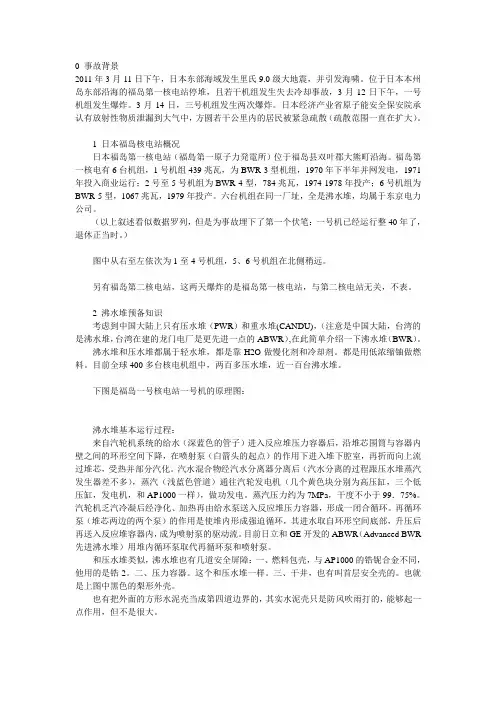
0 事故背景2011年3月11日下午,日本东部海域发生里氏9.0级大地震,并引发海啸。
位于日本本州岛东部沿海的福岛第一核电站停堆,且若干机组发生失去冷却事故,3月12日下午,一号机组发生爆炸。
3月14日,三号机组发生两次爆炸。
日本经济产业省原子能安全保安院承认有放射性物质泄漏到大气中,方圆若干公里内的居民被紧急疏散(疏散范围一直在扩大)。
1 日本福岛核电站概况日本福岛第一核电站(福島第一原子力発電所)位于福岛县双叶郡大熊町沿海。
福岛第一核电有6台机组,1号机组439兆瓦,为BWR-3型机组,1970年下半年并网发电,1971年投入商业运行;2号至5号机组为BWR-4型,784兆瓦,1974-1978年投产;6号机组为BWR-5型,1067兆瓦,1979年投产。
六台机组在同一厂址,全是沸水堆,均属于东京电力公司。
(以上叙述看似数据罗列,但是为事故埋下了第一个伏笔:一号机已经运行整40年了,退休正当时。
)图中从右至左依次为1至4号机组,5、6号机组在北侧稍远。
另有福岛第二核电站,这两天爆炸的是福岛第一核电站,与第二核电站无关,不表。
2 沸水堆预备知识考虑到中国大陆上只有压水堆(PWR)和重水堆(CANDU),(注意是中国大陆,台湾的是沸水堆,台湾在建的龙门电厂是更先进一点的ABWR),在此简单介绍一下沸水堆(BWR)。
沸水堆和压水堆都属于轻水堆,都是靠H2O做慢化剂和冷却剂。
都是用低浓缩铀做燃料。
目前全球400多台核电机组中,两百多压水堆,近一百台沸水堆。
下图是福岛一号核电站一号机的原理图:沸水堆基本运行过程:来自汽轮机系统的给水(深蓝色的管子)进入反应堆压力容器后,沿堆芯围筒与容器内壁之间的环形空间下降,在喷射泵(白箭头的起点)的作用下进入堆下腔室,再折而向上流过堆芯,受热并部分汽化。
汽水混合物经汽水分离器分离后(汽水分离的过程跟压水堆蒸汽发生器差不多),蒸汽(浅蓝色管道)通往汽轮发电机(几个黄色块分别为高压缸,三个低压缸,发电机,和AP1000一样),做功发电。
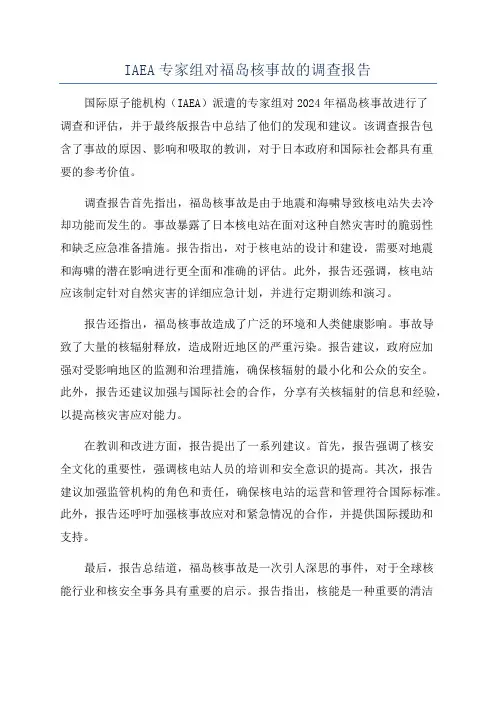
IAEA专家组对福岛核事故的调查报告国际原子能机构(IAEA)派遣的专家组对2024年福岛核事故进行了调查和评估,并于最终版报告中总结了他们的发现和建议。
该调查报告包含了事故的原因、影响和吸取的教训,对于日本政府和国际社会都具有重要的参考价值。
调查报告首先指出,福岛核事故是由于地震和海啸导致核电站失去冷却功能而发生的。
事故暴露了日本核电站在面对这种自然灾害时的脆弱性和缺乏应急准备措施。
报告指出,对于核电站的设计和建设,需要对地震和海啸的潜在影响进行更全面和准确的评估。
此外,报告还强调,核电站应该制定针对自然灾害的详细应急计划,并进行定期训练和演习。
报告还指出,福岛核事故造成了广泛的环境和人类健康影响。
事故导致了大量的核辐射释放,造成附近地区的严重污染。
报告建议,政府应加强对受影响地区的监测和治理措施,确保核辐射的最小化和公众的安全。
此外,报告还建议加强与国际社会的合作,分享有关核辐射的信息和经验,以提高核灾害应对能力。
在教训和改进方面,报告提出了一系列建议。
首先,报告强调了核安全文化的重要性,强调核电站人员的培训和安全意识的提高。
其次,报告建议加强监管机构的角色和责任,确保核电站的运营和管理符合国际标准。
此外,报告还呼吁加强核事故应对和紧急情况的合作,并提供国际援助和支持。
最后,报告总结道,福岛核事故是一次引人深思的事件,对于全球核能行业和核安全事务具有重要的启示。
报告指出,核能是一种重要的清洁能源,但同时也伴随着风险和挑战。
因此,全球需要加强对核电站的管理和监管,并推动技术的发展和创新,以提高核能的安全性和可持续性。
总的来说,IAEA专家组对福岛核事故的调查报告提供了一个全面而深入的分析,对于吸取教训、改进核电站的安全性和应对核灾害具有重要的指导意义。
同时,报告也强调了国际合作和共享信息的重要性,以共同应对核能发展中的挑战和风险。
日本福岛核电站事故及其影响分析(1)FDS(先进核能研究)团队2011年3月11日14时46分,日本本州岛附近海域发生里氏9.0级强震,地震及其引发的海啸导致了日本福岛核电站一站1~4号反应堆发生事故,并引发可能的核辐射危机。
事故现状:事态基本控制住日本福岛核电站是世界最大的核电站之一,由福岛一站、福岛二站组成,共有10台机组(一站6台,二站4台)。
福岛核电站是上世纪70年代建成并投入商业运行的沸水反应堆。
沸水堆核电站的冷却剂流过堆芯后直接变成高压蒸汽和水的混合物,经过汽水分离器和蒸汽干燥器,将分离出的蒸汽用来推动汽轮发电机组发电。
沸水堆原理示意图3月11日地震发生时,福岛一站的1~3号机组正在运行,4~6号机组处于停堆检修状态。
地震和海啸发生后,1~3号机组立即自动停堆。
但电站的外电网全部瘫痪,同时备用柴油发电机由于被海啸摧毁未能正常工作,致使反应堆停堆余热排除系统完全失效,导致1,2,3,4号机组相继发生氢气爆炸或大火。
经过多方努力,目前局势已得到初步控制,电厂电力已部分恢复,机组状态也相对稳定,以下是截至22日上午10时,第一核电站的机组状况:事故的主要原因:反应堆的停堆余热未能及时排出核反应堆停堆后,其功率并不是像火电站一样立即降为零,而是以正常功率的百分之几继续释放出衰变余热,并逐渐减小,但是这部分停堆余热的热量仍然很大,因此,在反应堆停堆后还必须采取一定的措施对堆芯进行冷却,以便排出这些热量防止损坏燃料组件及避免放射性物质的泄漏。
另外,乏燃料从反应堆堆芯取出后,需暂时保存在厂房内的一个开放式水池(乏燃料池)里面,继续冷却以排出衰变余热。
本次事故就是由于地震和海啸导致了反应堆冷却系统未能正常工作,而无法排出1~3号反应堆堆芯及4号堆乏燃料的衰变余热。
数次爆炸是氢气爆炸而不是核爆地震发生后4天内福岛核电站1~4个机组相继发生若干次爆炸。
爆炸导致1~4号反应堆的厂房损坏,同时2号反应堆的压力控制池也遭到破坏。
日本大地震引发的福岛核事故及对电力系统的影响情况通报(2011年3月31日)2011年3月11日,日本宫城县海域发生9.0级世纪大地震,并引发破坏性极高的海啸,造成了重大人员伤亡和巨额财产损失。
截至3月30日,已造成11258人死亡,16344人失踪。
大地震及引发的海啸等大规模次生灾害重创日本电力系统。
东京电力公司所属福岛第一核电站发生严重核泄漏事故,严重级别可能高达6级,即“严重事故”。
目前,附近海域和环境放射性物质严重超标,相邻国家相继监测出微量放射性核素,事故的影响仍在逐步扩大,预计后续处理可能仍需很长时间。
此次大地震引发的核泄漏事故以及电力供应危机,将给日本及全球的能源电力发展和电网安全生产带来深刻影响。
东京电力公司在生产管理和应急机制方面的缺陷和教训也值得电力企业深入分析、引以为戒。
一、日本电力工业概况日本是一个能源短缺、资源非常贫乏的国家,只有少量水能和煤炭,其他能源必须大量依赖进口。
日本的电力生产主要依靠火电(燃料主要是液化天然气LNG和煤炭)、核电以及水电,其余的则是利用可再生能源的地热、风能和太阳能以及燃料电池等的发电。
2009年,日本总装机容量2.42亿千瓦,其中,核电装机4885万千瓦,占20.2%;水电装机4638万千瓦,占19.2%;煤电装机3795万千瓦,占15.7%; LNG6157万千瓦,占25.5%;燃油机组4620万千瓦,占19.1%;新能源装机53万千瓦,占0.2%。
表1 2009年、2014年(规划)日本装机容量及分类情况类别2009年情况2014年规划类别装机量(GW)占比(%)装机量(GW)占比(%)核电48.85 20.2 51.87 20.9水电46.38 19.2 47.81 19.2煤电37.95 15.7 40.37 16.2LNG 61.57 25.5 64.14 25.8燃油46.20 19.1 44.04 17.7新能源0.53 0.2 0.53 0.2总计241.5 100 248.75 100可以看出,日本由于电力需求增长较缓,发电装机规模增长不快,核电在发电装机中的占比增长较快。